Link:
https://dannyman.toldme.com/2011/01/23/gung-hay-fat-choy/
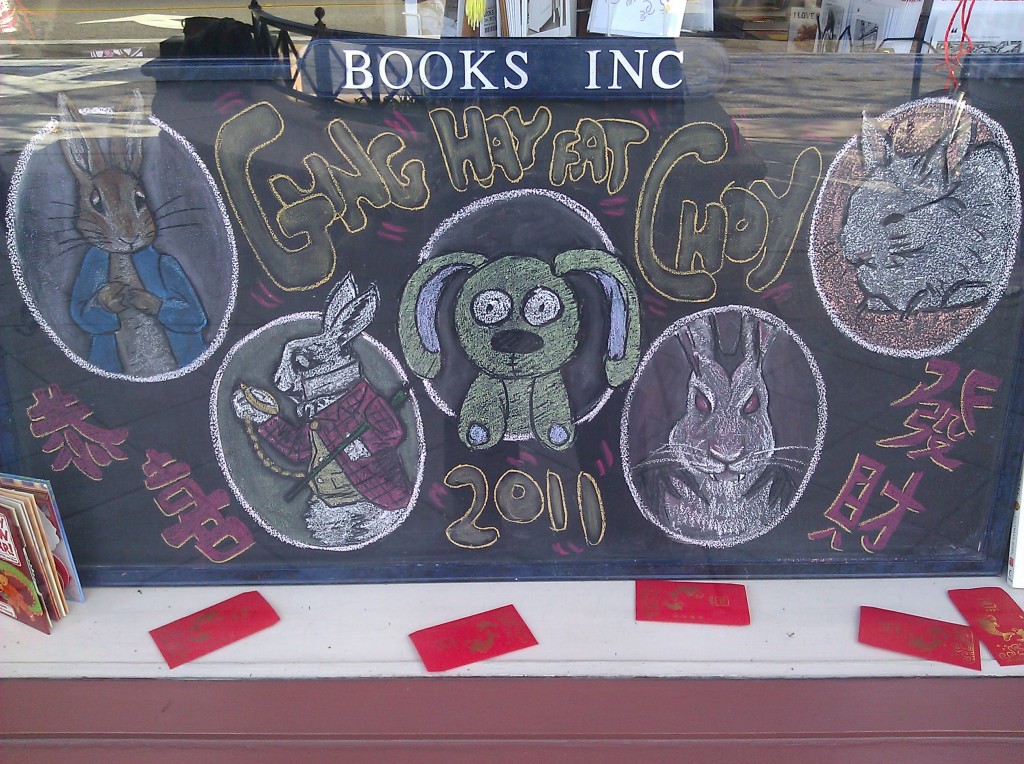
An assortment of rabbits to greet the Lunar New Year
At Books Inc, on Castro St in Mountain View, an assortment of literary rabbits has been beautifully rendered on a blackboard. From left to right I think we’ve got:
- Peter Rabbit
- The rabbit from “Alice in Wonderland”
- Knuffle Bunny (Thanks, Julie!)
- Bunnicula!
- Marshmallow
The approaching Lunar (Chinese) New Year is the Year of the Rabbit, which is the same as the Lunar New Year in which I was born. The red envelopes are called 红包, (literally “red envelope”) and they are for gifts of money given to kids.
“Gung Hay Fat Choy” I believe is a Cantonese transliteration of æå–œå‘è´¢, which in Mandarin is gong1 xi3 fa1 cai1. A further clue is that the Chinese characters on the chalk board are the traditional Chinese characters, used outside of the People’s Republic of China, and more familiar to past generations of Chinese immigrants, often from Southern China.
You can see that the traditional characters (top) look very similar to their simplified counterparts (bottom):
æ喜發財
æå–œå‘è´¢
2 Comments
Link:
https://dannyman.toldme.com/2010/01/15/google-china-luck-not-bad/
There’s been a lot of buzz in the tech community over Google’s Tuesday announcement that they are just totally fed up with the Chinese government’s utter contempt for human rights and for playing nice on the Internet, and that as a consequence they are going to remove either the censorship filters from Google.cn, or Google.cn from China.
I don’t entirely grasp Google’s strategy here, but if a plucky technology company that I admire wants to goad an autocratic government, I’m naturally inclined to sympathize with them.
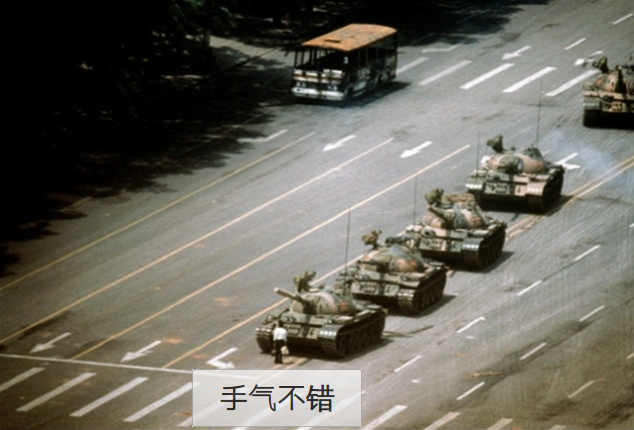
So, while it is still around, I figured I’d translate Google.cn‘s “I’m Feeling Lucky” button: 手气ä¸é”™
手 shuo3 is a pictograph for “hand”
æ°” qi4 is a pictograph for curling clouds, meaning “air”
ä¸ bu4 is a pictograph of a bird rising to heaven, which once meant “to soar” but today means “not”
é”™ cuo4 etymologically combines “metal” and “dried meat” for the archaic meaning “gilt” which nowadays means “mistake”
But don’t get hung up on hand-air-not-mistake as the characters combine to form two words:
手气 means luck
ä¸é”™ means “not bad” as in “pretty good”
So, 手气ä¸é”™ translates for me as “luck not bad” and that is what I hope for both Google (è°·æŒ) and the ä¸å›½äºº.
2 Comments
Link:
https://dannyman.toldme.com/2009/06/23/ensure-my-safety/
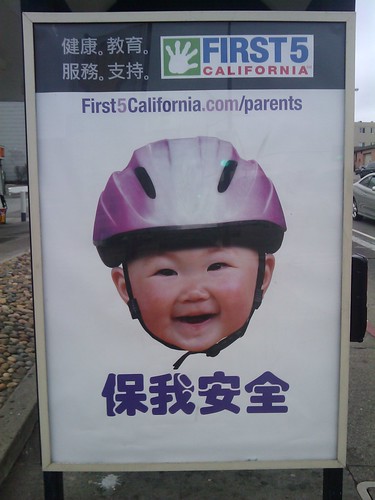
There’s a new billboard at the bus stop at 19th Ave and Taraval. I could read the first three characters with my own little brain:
ä¿ Insurance
我 I
安 Safety / shelter
Looking up the fourth character: 全 (all) I see that the last two characters together mean "safety". 安 is easy to remember, because "woman under a roof" means safety / shelter / security.
ä¿æˆ‘安全
bao3wo3an1quan2
Ensure My Safety
There are many insurance agencies in the neighborhood.
4 Comments
Link:
https://dannyman.toldme.com/2009/06/10/bones/

Dialogue from two ChinesePod lessons: Can You Use Chopsticks? and Does it Have Bones?
Man: ä½ ä¼šç”¨ç·å马?
ni3 hui4 yong4 kuai4zi ma?
You can use chopsticks?
Woman: 当然会。 ä½ çœ‹ï¼
dang1ran2 hui4. ni3 kan4!
Certainly can. You see!
Man: å“‡ï¼ çœŸåŽ‰å®³ï¼
wa1! zhen1 li4hai!
Whoa! Truly awesome!
Woman: 这个很好åƒï¼
zhe4ge hen3 hao3chi1!
This is so delicious!
Man: 有没有骨头?
you3 mei2you3 gu3tou?
Does it have bones?
Woman: æœ‰ï¼ å¾ˆå¥½åƒï¼
you3! hen3 hao3chi1!
Yes! Very tasty!
Man: 我ä¸åƒéª¨å¤´ã€‚
wo3 bu4 chi1 gu3tou.
I don’t eat bones.
会 = hui4 = can do something
用 = yong4 = use
ç·å = kuai4zi = chopsticks
å¥½åƒ = hao3chi1 = “good eat” = delicious (é¢åŒ…个很好åƒï¼)
有没有 = you3mei2you3 = “have-not-have” (does it have . . .)
有 = you3 = “have” (yes)
没有 = mei2you3 = “not have” (no)
骨头 = gu3tou = bones
Yeah, it has been awhile. This time through, 骨头 threw me for a bit of a loop because the character rendered differently in a certain font. According to my dictionary, 骨 is a compound of a skull-with-vertebrae (冎) over flesh (肉) though the bottom particle is drawn as a moon (月) except in one font it came out with the skull facing right, and the two horizontal strokes in the moon slanted downward in opposite directions to better resemble flesh. This appears to be question of style.
骨?
Meanwhile, if you combine a dog (犬) with a bone (骨) you get sly (猾). It seems that the homonym 滑, water (水) plus bone is more common but I like that the sly dog gets his bone.
The other thing I did is after scanning the drawing I ran the scan through the Potrace bitmap tracing engine in Inkscape, which converted the lines to a vector graphic, smoothing things out somewhat.
2 Comments
Link:
https://dannyman.toldme.com/2009/04/01/too-heavy/

Girl: 我的包太é‡äº†ï¼
wo3 de bao1 tai4 zhong4le
My bag is too heavy!
Boy: 我拿å§ï¼
wo3 na1 ba
I’ll carry it!
Girl: 好,给ï¼
hao3, gei3
Good, here!
Boy: 呃,真的很é‡ï¼
e4, zhen1 de hen3 zhong1
Hey, it really is very heavy!
包 = bag
é‡ = heavy
很 = very
ç»™ = take
呃 = onomatopoeia, “eh”
From ChinesePod: Newbie: Too Heavy! I fall ever further behind. This one I actually drew a couple times and in the end I’m still not super thrilled about the result, but hey that’s all part of the process here. I see my friend 包, as seen in é¢åŒ… and the 红包 in “新年好!”. Just as the girl in “新年好!” was invited to 给她红包 the boy here gets to 给包太é‡äº†.
Thanks, Joe, for nudging me along.
Feedback Welcome
Link:
https://dannyman.toldme.com/2009/02/25/wait-up/

Based on ChinesePod: Hold the Elevator.
Suit: ç‰ä¸€ä¸‹ï¼
deng3 yi1xia4
Wait up!
Suit: 谢谢。
xie4xie
Thanks.
Courier: ä¸å®¢æ°”ï¼Œåˆ°å‡ æ¥¼ï¼Ÿ
bu4ke4qi, dao4 ji3 lou2?
No problem, which floor?
Suit: å楼。 è°¢è°¢ä½ ï¼
shi2 lou2. xie4xie ni3!
Tenth floor. Thank you!
ä¸å®¢æ°” I like, as I learned it from speaking with Chinese people and because it literally means “not polite” or “don’t be so polite” which reminds me of de nada or de rien.
This time I dropped (forgot) the pinyin and just left it out. Though I think it is better to include the pinyin: one thing I do is print out the cartoons and tack them to my cubicle wall at work. I was also happy to recycle the delivery man from â€œä½ çš„ä¸œè¥¿â€.
Feedback Welcome
Link:
https://dannyman.toldme.com/2009/02/16/your-thing/
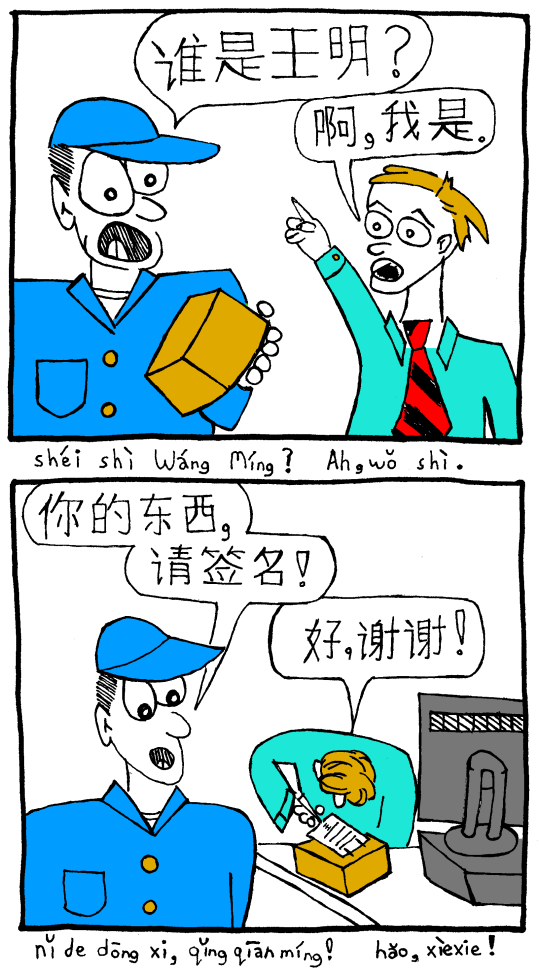
Based on ChinesePod Lesson: Sign Here, Please.
Courier: è°æ˜¯çŽ‹æ˜Žï¼Ÿ
(Who is Wang Ming?)
Ming: 阿,我是。
(Ah, I am.)
Courier: ä½ çš„ä¸œè¥¿, 清ç¾åï¼
(Your parcel. Please signï¼)
Ming: 好,谢谢ï¼
(Good! Thanks!)
I like that ä½ çš„ä¸œè¥¿ literally means “your thing”
There is a vastly different courier in the top and bottom panels. The first one is more comical and bizarre, the bottom one more . . . human? I prefer the bottom figure, but decided against trying to correct the situation. Aesthetically, it is also weird that in the second panel Ming is more in the background. I think that’s okay but in terms of visual narrative, yaknow . . . ?
Feedback Welcome
Link:
https://dannyman.toldme.com/2009/02/09/gong-xie-fa-cai/
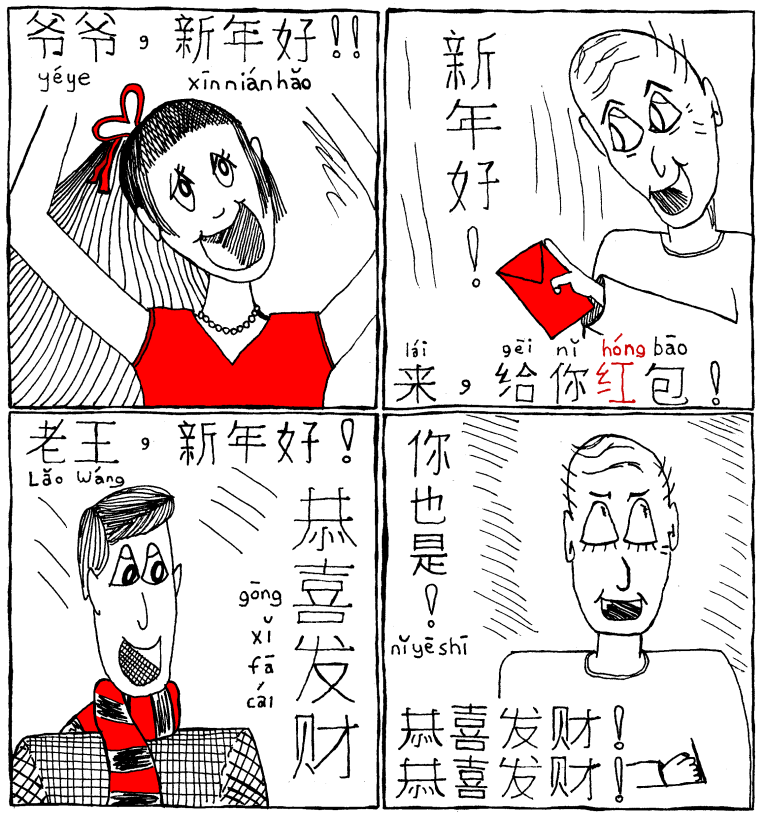
This is an illustration of the dialog in ChinesePod Lesson “Gong Xi Fa Cai”
Kid: 爷爷,新年好ï¼
Grandpa: 新年好ï¼æ¥ï¼Œç»™ä½ 红包ï¼
Adult: è€çŽ‹ï¼Œæ–°å¹´å¥½ï¼æå–œå‘è´¢ï¼
Grandpa: ä½ ä¹Ÿæ˜¯ï¼æå–œå‘è´¢ï¼æå–œå‘è´¢ï¼
You can listen to the audio to grok what all that means.
新年好 = xin1 nian4 hao3 = “new year good” = “Happy New Year”
æå–œå‘è´¢ = gong1 xi3 fa1 cai1 = “Wishing you a prosperous New Year”
æå–œ = “respectful happiness” = “congratulations”
å‘è´¢ = “to get rich”
æå–œå‘è´¢ does not translate well if you take it literally.
红包 = hong2 bao1 = “red envelope”
You give gifts of money to children in red envelopes. 红包!
红 and 包 I have drawn before. 红鱼 is the “red fish” and é¢åŒ… is bread.
The other day we ate hot pot at è€åŒ—京 . . . at least, I was able to read “Beijing” and as I drew this I recognized “old Beijing” . . . the restaurant is called “Old Mandarin Islamic Restaurant”. Beijing I like because it simply means “North Capital City”
Last night we were at Temple Night Club and I saw a big old 爱 and I recognized it as å‘ with more up top. 爱, pronounced ai3 is “love” and saying “I love you” in Chinese is as simple as æˆ‘çˆ±ä½ = wo3 ai4 ni3 .
In addition to the Chinese characters, drawing the (Chinese) human characters was somewhat challenging as well. I am most happy with the girl. After trying to figure out how best to draw a “cute little Chinese girl” I ended up basing my character just a teeny bit on Lin Miaoke, the infamous “Beijing Olympics ‘lip-synch’ Girl”.
Feedback Welcome
Link:
https://dannyman.toldme.com/2009/02/02/mianbao/
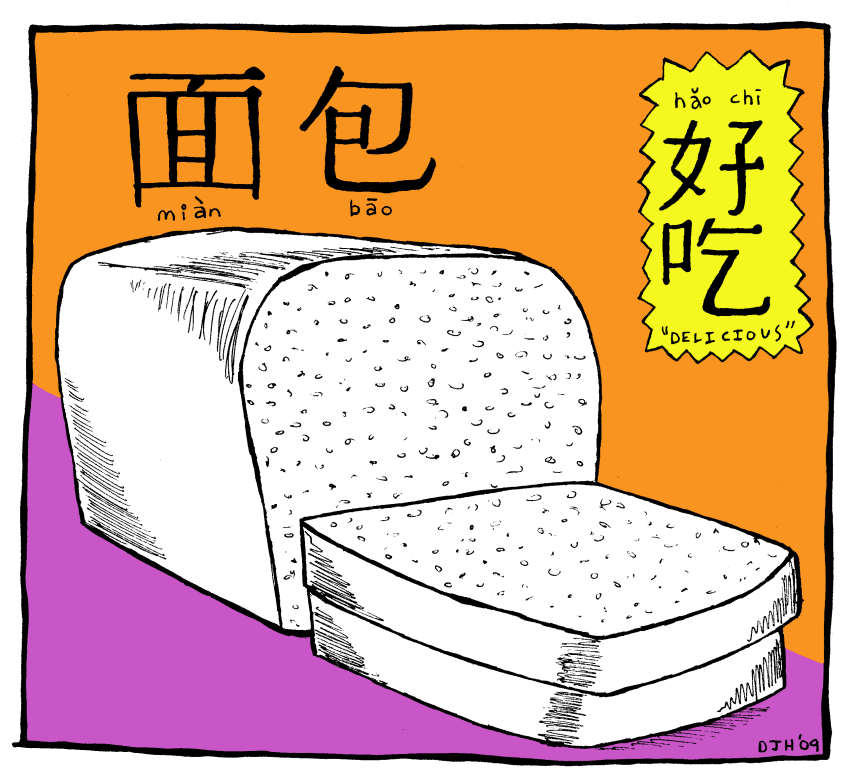
I recently made wheat bread and stored it in zip-lock bags. Then when I finished the bread I thought I could re-use the bags, but I should label what was stored in them so that I could store comparable foods. Then I figured I might as well get bilingual, so now I have three zip-lock bags labeled “BREAD é¢åŒ…”
On Thursday evening I met with the Cartoonist Conspiracy San Francisco group. I’m not a hard-core cartoonist but I felt welcomed and I got some practice inking in some panels in different styles. I had wanted to get some thicker lines going, so here I did the characters with a sharpie, other lines, like the bread crust, are inked over about 5 times with my 0.7mm pen. And then we have some actual shading. Whooo! I added the colors after scanning.
I effed up in that the slices do not match the shape of the loaf.
Feedback Welcome
Link:
https://dannyman.toldme.com/2009/01/26/happy-niu-year/
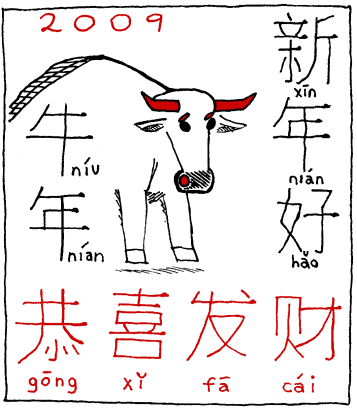
æå–œå‘è´¢!
ChinesePod.com has a lesson on New Year greetings.
牛 == niu(2) == ox
å¹´ == nian(2) == year
æ–° == xin(1) == new
So . . .
牛年 == Year of the Ox (“ox year”)
新年好 == Happy New Year (“new year good”)
æå–œå‘è´¢ == Wish for a Prosperous New Year
And of course, red is a good luck color, which is why you give kids money in red envelopes. At least, if you are Chinese. I just give them candy corn.
1 Comment
Link:
https://dannyman.toldme.com/2009/01/23/nihao-kitty/

I have to give a shout out to this web site which provides both word translations and illustrated explanations of characters. 谢谢! I forgot about the pinyin while drawing this with the pencil, and when I went to sneak it in the right-hand corner I did it in pen right off the bat. After scanning, I used Gimp to clean up a few lines and to re-draw the left half of the 猫. Funny enough, the left half of the character, which means “cat” was a bit larger and looked like it was part of kitty-chan herself. So, I re-drew it smaller in Gimp.
And I skipped the English translation since it was somewhat obvious.
ä½ å¥½ == ni(3)hao(3) == hello
猫 == mao(1) == cat
å’ª == mi(1) == meow
猫咪 == mao(1)mi(1) == kitty
Best I can tell, if you inquired about ä½ å¥½ 猫咪 in China people would be puzzled, since around the world this Japanese emissary of cuteness and love is known by her English name: “Hello Kitty”.
Feedback Welcome
Link:
https://dannyman.toldme.com/2009/01/21/one-fish-two-fish/
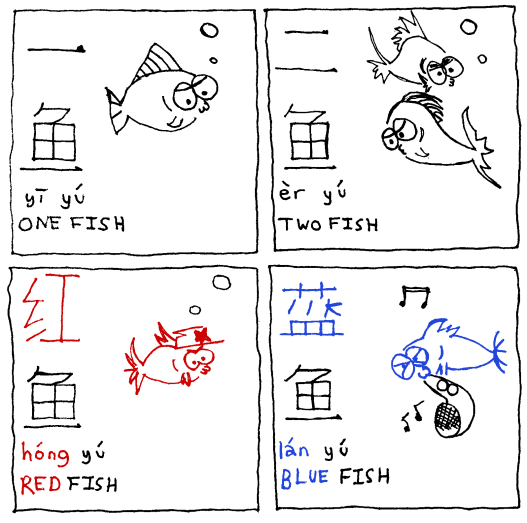
I was thinking maybe just maybe I might enroll in a Chinese class. Then I might even learn something, but CCSF started classes last week. I also been thinking it might be great to get more of a regular habit of drawing or doodling. Then I was thinking I might as well just wrap them up together, and illustrate Chinese words. So, here we go: a little homage to Dr Seuss!
4 Comments
Link:
https://dannyman.toldme.com/2008/09/25/over-the-top/
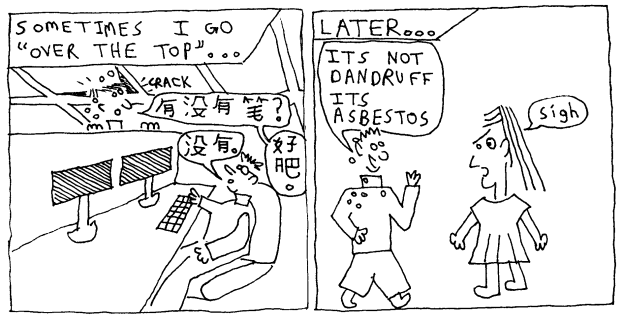
If you would like to understand the Chinese, check out “Do you have . . . ?” from ChinesePod.com.
有没有笔?
(yÇ’u méiyÇ’u bÇ?)
Gotta pen?
没有.
(méiyǒu.)
Nope.
好å§.
(háo bÄ.)
Okay.
It is neat how the asking works: yÇ’u méiyÇ’u literally means “have not-have.”
Incidentally, if anyone knows how to type the pinyin with the accent marks, please clue me in. Thanks!
Feedback Welcome
Site Archive













